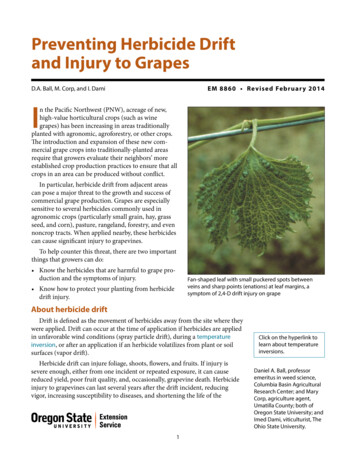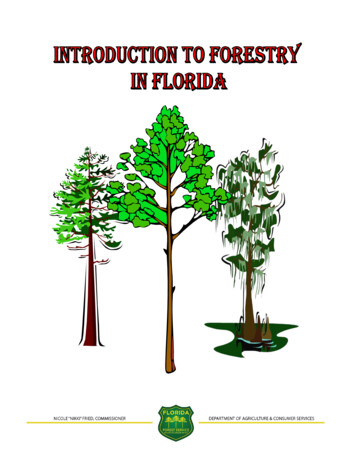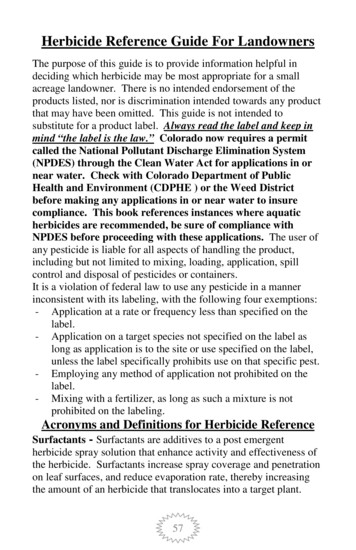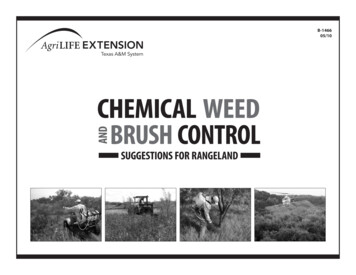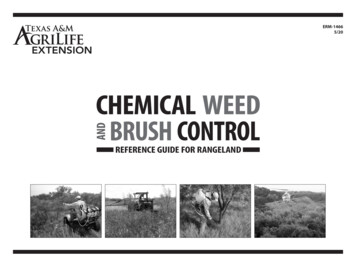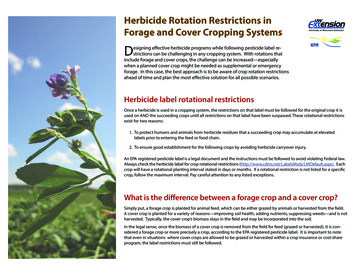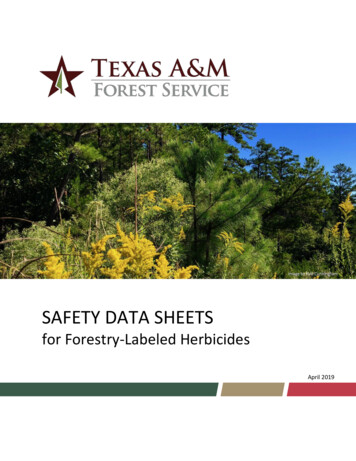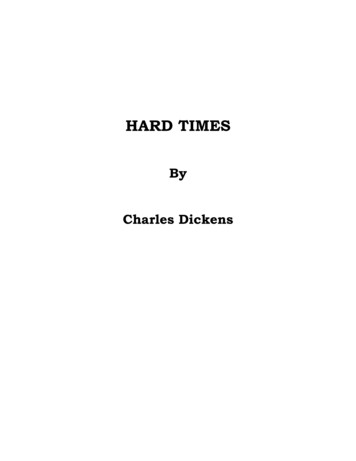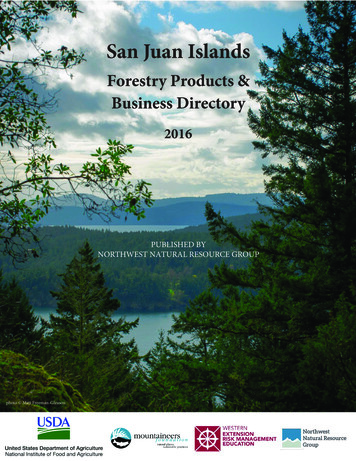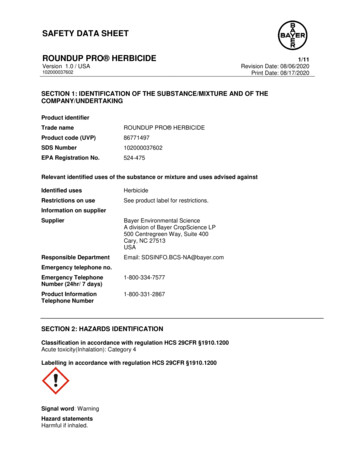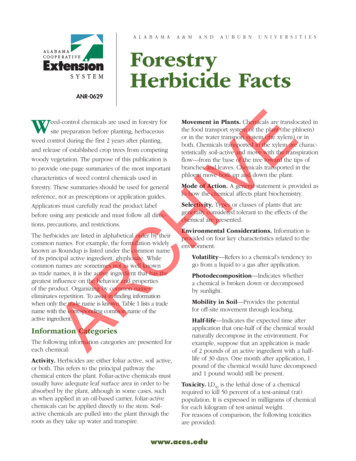
Transcription
A l a b a m aANR-0629A & Ma n dA u b u r nU n i v e r s i t i e sForestryHerbicide FactsWMovement in Plants. Chemicals are translocated inthe food transport system of the plant (the phloem)or in the water transport system (the xylem) or inboth. Chemicals transported in the xylem are characteristically soil-active and move with the transpirationflow—from the base of the tree toward the tips ofbranches and leaves. Chemicals transported in thephloem move both up and down the plant.IVEeed-control chemicals are used in forestry forsite preparation before planting, herbaceousweed control during the first 2 years after planting,and release of established crop trees from competingwoody vegetation. The purpose of this publication isto provide one-page summaries of the most importantcharacteristics of weed control chemicals used inforestry. These summaries should be used for generalreference, not as prescriptions or application guides.Applicators must carefully read the product labelbefore using any pesticide and must follow all directions, precautions, and restrictions.Mode of Action. A general statement is provided asto how the chemical affects plant biochemistry.HSelectivity. Types or classes of plants that aregenerally considered tolerant to the effects of thechemical are presented.ARCThe herbicides are listed in alphabetical order by theircommon names. For example, the formulation widelyknown as Roundup is listed under the common nameof its principal active ingredient, glyphosate. Whilecommon names are sometimes not as well knownas trade names, it is the active ingredient that has thegreatest influence on the behavior and propertiesof the product. Organizing by common nameseliminates repetition. To assist in finding informationwhen only the trade name is known, Table 1 lists a tradename with the corresponding common name of theactive ingredient.Information CategoriesThe following information categories are presented foreach chemical:Activity. Herbicides are either foliar active, soil active,or both. This refers to the principal pathway thechemical enters the plant. Foliar-active chemicals mustusually have adequate leaf surface area in order to beabsorbed by the plant, although in some cases, suchas when applied in an oil-based carrier, foliar-activechemicals can be applied directly to the stem. Soilactive chemicals are pulled into the plant through theroots as they take up water and transpire.Environmental Considerations. Information isprovided on four key characteristics related to theenvironment:Volatility—Refers to a chemical’s tendency togo from a liquid to a gas after application.Photodecomposition—Indicates whethera chemical is broken down or decomposedby sunlight.Mobility in Soil—Provides the potentialfor off-site movement through leaching.Half-life—Indicates the expected time afterapplication that one-half of the chemical wouldnaturally decompose in the environment. Forexample, suppose that an application is madeof 2 pounds of an active ingredient with a halflife of 30 days. One month after application, 1pound of the chemical would have decomposedand 1 pound would still be present.Toxicity. LD50 is the lethal dose of a chemicalrequired to kill 50 percent of a test-animal (rat)population. It is expressed in milligrams of chemicalfor each kilogram of test-animal weight.For reasons of comparison, the following toxicitiesare provided:www.aces.edu
Table 1. Weed Control Products Used in ForestryNicotine LD50 50 mg/kg (high toxicity)Caffeine LD50 192 mg/kg (moderate toxicity)ProductActive IngredientTable salt LD50 3,000 mg/kg (low toxicity)AatrexatrazineNote that for the LD50 measure of toxicity, the lowerthe number the more toxic the mbaChopperimazapyr2,4-D2,4-DEscortmetsulfuronThis section provides only the more commonformulations and in no way lists all the commerciallyavailable products for all active al Sources of InformationMilestoneaminopyralid CDMS agro-chemical database: www.cdms.netOustsulfometuron National Pesticide Information baIVEProduct Formulation. Active ingredients are oftensold under one or more formulations. This sectionprovides the percentage of the active ingredient andindicates whether it is an amine (water soluble) orester (oil soluble) liquid or a dry formulation. Tradenames and manufacturers are also given.H Crop Protection Handbook. Vol. 97. Willoughby,OH: Meister Media Worldwide, 2011.C Herbicide Handbook. 10th ed. Champaign, IL:Weed Science Society of America, ivityFoliar and soil activeMovement in plantsTranslocated in both the xylem and phloemMode of actionGrowth regulatorSelectivityPasture grasses and small-grains tolerantEnvironmental onRapid in water, stable on soilMobility in soilLowHalf-life34 daysToxicityLD50 - 5,000 mg/kg (practically nontoxic)Product FormulationTrade Name and ManufacturerWater-soluble liquid2.22 percent aminopyralidMilestone VM Plus (Dow AgroSciences)2 Alabama Cooperative Extension System
atrazineActivityPrimarily soil, some foliar activityMovement in plantsTranslocated in the xylemMode of actionPhotosynthesis inhibitorSelectivityBroad-spectrum broadleaf and grass control; minimallyeffective on established weeds; used as a preemergentor early postemergentEnvironmental leMobility in soilHighly water-soluble but readily adsorbed by organicmatter and clay; potential for leaching on sandy soilsIVEVolatilityHalf-life60 daysLD50 - 3,080 mg/kg (low toxicity)ToxicityProduct FormulationTrade Name and ManufacturerWater-soluble liquid43 percent atrazineAatrex 4L (syngenta)Aatrex Nine-O (syngenta)HWater-dispersible granule88 percent atrazineclopyralidActivityMostly foliar but is absorbed by rootsMode of actionSelectivityCMovement in plantsTranslocated in both the xylem and phloemGrowth regulatorHighly effective against many legumesGrasses generally tolerantEnvironmental tionNegligibleMobility in soilModerateHalf-life14–56 days, typically around 40 daysToxicityLD50 - 5,000 mg/kg (practically nontoxic)Product FormulationTrade Name and ManufacturerWater-soluble liquid41 percent clopyralidTransline (Dow AgroSciences)Forestry Herbicide Facts3
2,4-DActivityFoliarMovement in plantsTranslocated in both xylem and phloemMode of actionGrowth regulatorSelectivityGrasses generally tolerantEnvironmental ConsiderationsRelated to formulation; volatility can be a problem withester formulationsPhotodecompositionNegligibleMobility in soilRapid degradation and plant uptake minimizesmobility; leaching potential in sandy soilsHalf-life10 daysIVEVolatilityLD50 - 639 mg/kg – 1,646 mg/kg (low toxicity)ToxicityProduct FormulationTrade Name and ManufacturerWater-soluble liquid40 percent 2,4-DHi-Dep Broadleaf Herbicide (Gordon’s AgriculturalProducts)Water-soluble liquid21 percent 2,4-D amine plus 5 percent picloramPathway (Dow AgroSciences)Tordon RTU (Dow AgroSciences)Water-soluble liquid40 percent 2,4-D plus 10 percent picloramTodon 101 Mixture (Dow AgroSciences)Weedone LV4 (Nufarm)HForms an emulsion when mixed with water63 percent 2,4-D esterCForms an emulsion when mixed with water; soluble inpetroleum distilates; 87 percent 2,4-D esterWeedone 650 (Nufarm)dicambaActivityFoliar and soilTranslocated in both the xylem and phloemMode of actionGrowth regulatorARMovement in plantsSelectivityGrasses generally tolerantEnvironmental onNegligibleMobility in soilRelatively mobile in soil, but degrades rapidlyHalf-life14 daysToxicityLD50 - 1,707 mg/kg (low toxicity)Product FormulationTrade Name and ManufacturerWater-soluble liquid40 percent dicambaBanvel (Arysta LifeScience)Water-soluble liquid13 percent dicamba plus 25 percent 2,4-D amineBanvel 720 (Arysta LifeScience)Ready-to-use water-based liquid13 percent dicambaBanvel CST (Arysta LifeScience)4 Alabama Cooperative Extension System
fosamineActivityFoliarMovement in plantsTranslocated in both the xylem and phloemMode of actionGrowth regulator; stops bud developmentSelectivityLabeled for broad-spectrum woody plant controlEnvironmental leMobility in soilNegligibleHalf-life8 daysToxicityLD50 - 5,000 mg/kg (practically nontoxic)IVEVolatilityProduct FormulationTrade Name and ManufacturerWater-soluble liquid42 percent fosamineKrenite S (Albaugh Inc.)ActivityFoliarMovement in plantsTranslocated in both the xylem and phloemInhibits the synthesis of specific amino acidsCMode of tal ty in soilTightly bound to soil and organic matterHalf-life47 daysToxicityLD50 - 5,000 mg/kg (practically nontoxic)Product FormulationTrade Name and ManufacturerWater-soluble liquid41 percent glyphosateRoundup Pro (Monsanto)Water-soluble liquid50 percent glyphosateRoundup Pro Concentrate (Monsanto)Water-soluble liquid54 percent glyphosate plus surfactantAccord XRT (Dow AgroSciences)Water-soluble liquid54 percent glyphosate, no surfactantAccord Concentrate (Dow AgroSciences)Water-soluble liquid52 percent glyphosateRefuge (Sygenta)ARPhotodecompositionForestry Herbicide Facts5
hexazinoneActivityPrimarily soil-active; some foliar activityMovement in plantsTranslocated in the xylemMode of actionInhibits photosynthesisSelectivityBroad-spectrum control with some conifer toleranceEnvironmental ConsiderationsNegligiblePhotodecompositionSlow; reported to be 10 percent per weekMobility in soilAdsorbed by organic matter and clay; highly watersoluble with potential for leaching on sandy soilsHalf-life90 daysIVEVolatilityToxicityLD50 - 1,690 mg/kg (low toxicity)Product FormulationsTrade Name and ManufacturerWater-dispersible liquid25 percent hexazinoneVelpar L (Dupont)Oustar (Dupont)Dry flowable75 percent hexazinoneVelpar DF (Dupont)HDispersible granules63 percent hexazinone plus 12 percent sulfometuronimazapyrFoliar and soilCActivityMovement in plantsTranslocated in the xylem and phloemMode of actionInhibits the synthesis of specific amino acidsSelectivityConifers generally tolerantAREnvironmental onSignificant in water, slow on soilsMobility in soilAdsorbed by soil particles; leaching usually not aproblemHalf-life27 daysToxicityLD50 - 5,000 mg/kg (practically nontoxic)Product FormulationsTrade Name and ManufacturerWater-soluble liquid53 percent imazapyrArsenal Applicators Concentrate(BASF)Oil- or water-soluble liquid28 percent imazapyrChopper(BASF)Water-soluble liquid27 percent imazapyrChopper Gen2(BASF)Dispersible granules63 percent imazapyr plus 10 percent metsulfuronLineage Clearstand(Dupont)6 Alabama Cooperative Extension System
metsulfuronActivityFoliar and soilMovement in plantsTranslocates in both the xylem and phloemMode of actionInhibits the synthesis of specific amino acidsSelectivityBroad-spectrum herbicide with some conifer toleranceEnvironmental leMobility in soilLow adsorption to clay but some adsorption to organicmatter; solubility increases with increasing pH; someleaching potential but use rates very lowIVEVolatilityHalf-life30 daysToxicityLD50 - 5,000 mg/kg (practically nontoxic)Product FormulationTrade Name and ManufacturerDry flowable60 percent metsulfuron methylEscort XP (Dupont)Lineage Clearstand(Dupont)HDispersible granules10 percent metsulfuron plus 63 percent imazapyrpicloramActivitySoil and foliarMode of actionSelectivityCMovement in plantsTranslocated in both the xylem and phloemGrowth regulatorBroad-spectrum herbicide although mostgrasses tolerantEnvironmental tionReported to photodecompose but actual rates notconclusively measuredMobility in soilVery mobile in soilHalf-life90 daysToxicityLD50 - 5,000 mg/kg (practically nontoxic)Product FormulationTrade Name and ManufacturerWater-soluble liquid24 percent picloramTordon K (Dow AgroSciences)Water-soluble liquid10 percent picloram plus 40 percent 2,4-DTordon 101 Mixture (Dow AgroSciences)Water-soluble liquid, ready to use5 percent picloram plus 21 percent 2,4-DTordon RTU (Dow AgroSciences)Ready-to-use liquid5 percent picloram plus 21 percent 2,4-DPathway (Dow AgroSciences)Water-soluble liquid24 percent picloramTordon 22K (Dow AgroSciences)Forestry Herbicide Facts7
sulfometuronActivitySoil and foliarMovement in plantsTranslocates in both the xylem and phloemMode of actionInhibits the synthesis of specific amino acidsSelectivityConifers and other woody perennials tolerantEnvironmental leMobility in soilMobility increases with higher pH; adsorbed by soilorganic matterHalf-life20–28 daysToxicityLD50 - 5,000 mg/kg (practically nontoxic)IVEVolatilityProduct FormulationTrade Name and ManufacturerWater-dispersible granule75 percent sulfometuronOust (Dupont)Water-dispersible granule12 percent sulfometuron plus 63 percent hexazinoneOustar (Dupont)triclopyrActivityFoliarMovement in plantsNot known exactly but similar to 2,4-D and picloramHMode of actionTranslocated in both the xylem and phloemMost grasses tolerantSelectivityEnvironmental ConsiderationsCan be a problem with ester lity in soilNot readily leachedHalf-lifeARToxicity30 daysLD50 - 713 mg/kg (low toxicity)Product FormulationTrade Name and ManufacturerWater-soluble liquid44 percent triclopyr amineGarlon 3A (Dow AgroSciences)Water- and oil-soluble liquid62 percent triclopyr esterGarlon 4 (Dow AgroSciences)Water- and oil-soluble liquid84 percent triclopyrForestry Garlon XRT (Dow AgroSciences)Ready-to-use liquid14 percent triclopyrPathfinder II(Dow AgroSciences)Ken McNabb, Extension Forester, W. Kelly Mosley Environmental Professor, Forestry and Wildlife Sciences,Auburn UniversityUse pesticides only according to the directions on the label. Follow all directions, precautions, and restrictions that are listed. Do not use pesticides on plants that are not listed on the label.The pesticide rates in this publication are recommended only if they are registered with the Environmental Protection Agency and the AlabamaDepartment of Agriculture and Industries. If a registration is changed or cancelled, the rate listed here is no longer recommended. Before youapply any pesticide, check with your county Extension agent for the latest information.Trade names are used only to give specific information. The Alabama Cooperative Extension System does not endorse or guarantee any productand does not recommend one product instead of another that might be similar.For more information, contact your county Extension office. Visit www.aces.edu/directory.ANR-0629Published by the Alabama Cooperative Extension System (Alabama A&M University and Auburn University), an equal opportunity educator and employer.Revised Sept 2014, ANR-0629 2014 by the Alabama Cooperative Extension System. All rights reserved.
Hi-dep broadleaf Herbicide (Gordon’s Agricultural Products) Water-soluble liquid 21 percent 2,4-d amine plus 5 percent picloram Pathway (dow Agrosciences) tordon rtu (dow Agrosciences) Water-soluble liquid 40 percent 2,4-d plus 10 percent picloram todon 101 mixture (dow Agrosciences) Forms
